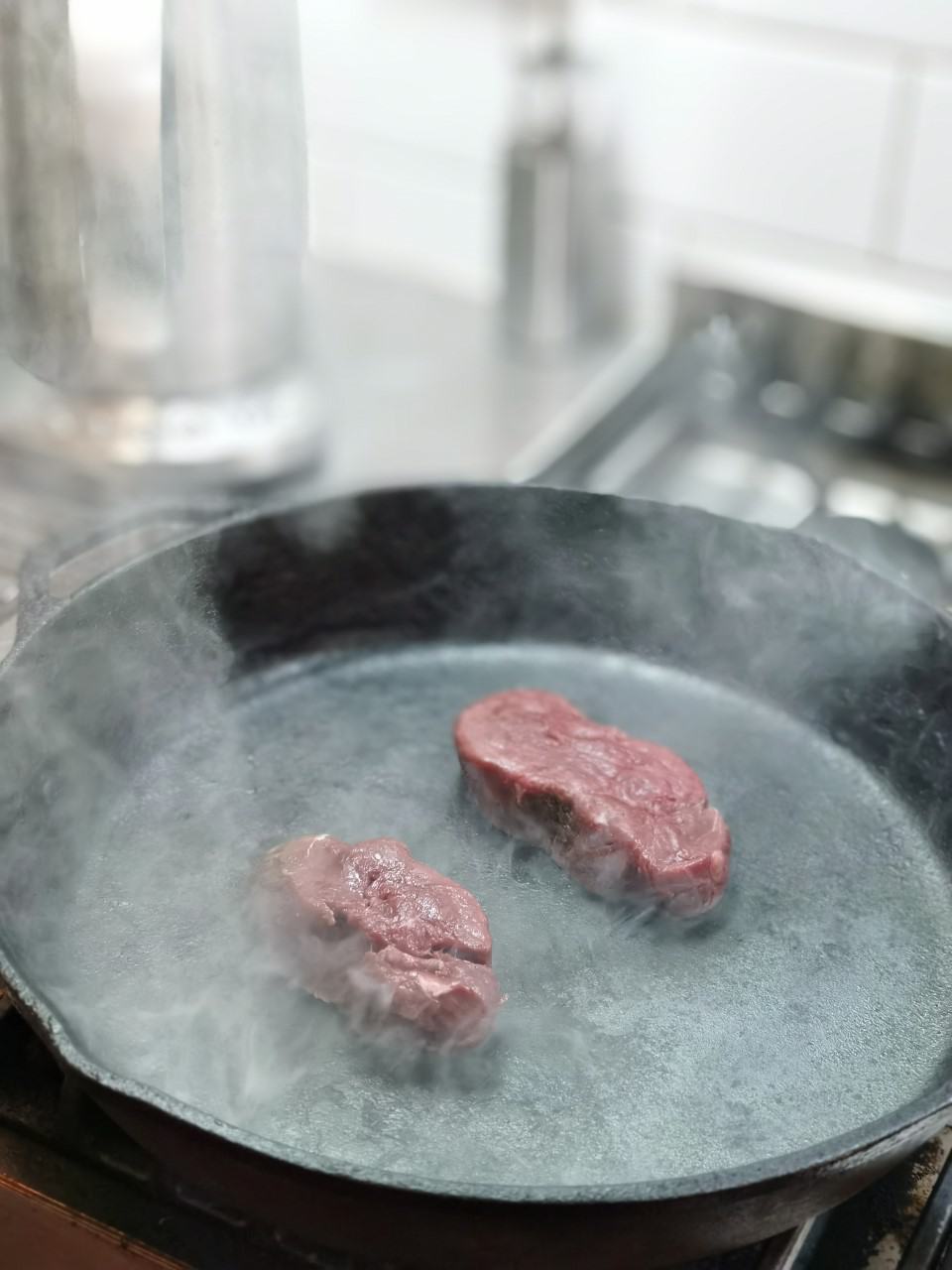PAT PILCHER gives the inside oil on how to cook a perfect steak. Everything you need to know in one place. Save the recipe!
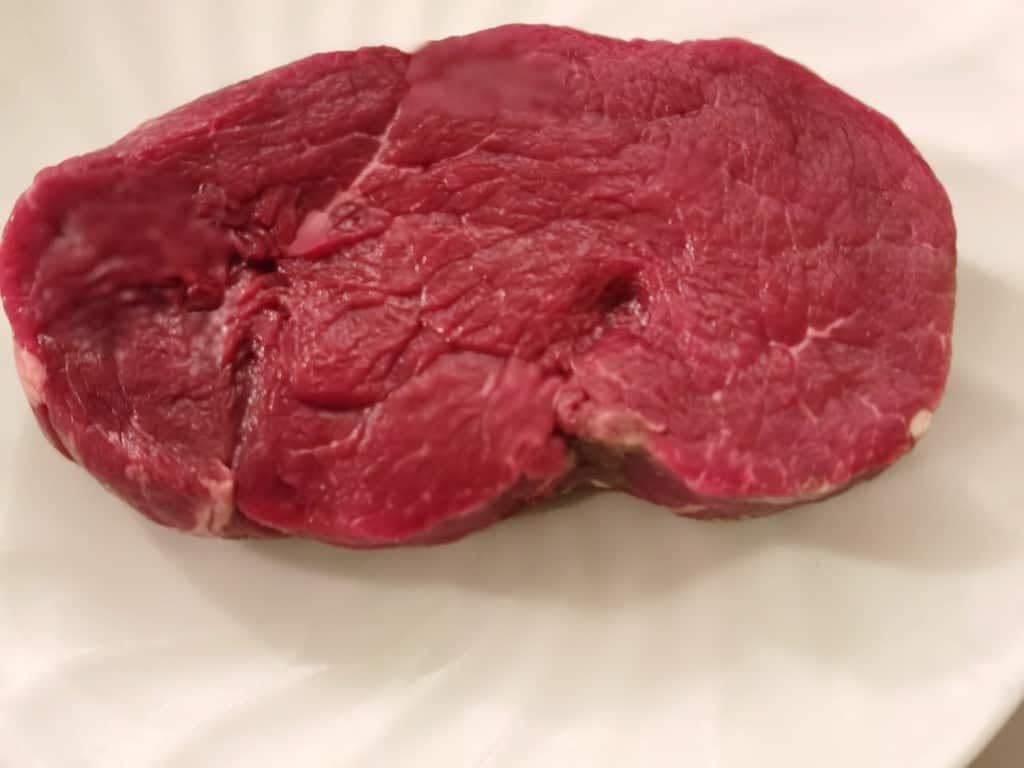
Want to cook a steak as good as you’d get in a restaurant? A few years back, I interviewed celeb chef Simon Gault on cooking the perfect steak. I’ve stuck with his method ever since, as it always delivers a tender yet tasty steak and it isn’t terribly difficult either. Here’s how.
- Buy a good cut of steak
First things first, when shopping for steak, go to a butcher. You’ll often get a better cut of meat and can find cuts that supermarkets don’t carry. Ask for 100 cold boned beef, and make sure the steak you buy is thick – aim for at least 200 to 250g per piece of steak. Experts say the best cuts start from the top of the cow down, starting with eye fillet (also known as tenderloin). Eye fillet gets followed by a scotch fillet, then porterhouse and rump. Most butchers hang a steak after trimming. Doing so helps a steak develop flavour and tenderises it. Most butchers say that a steak should get hung for 21 to 35 days.
When shopping for a steak, here’s what to look for:
Make sure the steak is firm. It should have a red colour with some marbling (fine streaks of fat). Marbling is a big deal as it melts when the steak is cooked. This helps develop a more delicious flavour. Avoid big clumps of fat too.
- Don’t marinate
There’s plenty of debate around marinating. Those who are pro marinating say a good marinade makes a cheap cut of steak tender. Others argue that marinating can take over the flavour. If you want a tender steak, buy a decent cut, and cook it slower at lower temperatures.
- Bring the steak to room temperature
Before you even think about cooking a steak, bring it to room temperature. This involves taking the steak out of the fridge at least 30 minutes before cooking. Keep it covered as it reaches room temperature. The rationale for this is simple:
If you put fridge temperature steak in a hot pan and cook it, it’ll dry it out before its inside begins to cook. This leads to a drier, tougher piece of meat. Because a room temperature steak cooks in less time, it cooks more evenly and will be more tender.
If your steak is fridge cold, and you don’t have enough time to bring it to room temperature, try this. Place the steak in an air-tight plastic container and immerse in warm water for 15-30 minutes.
- Salt the steak
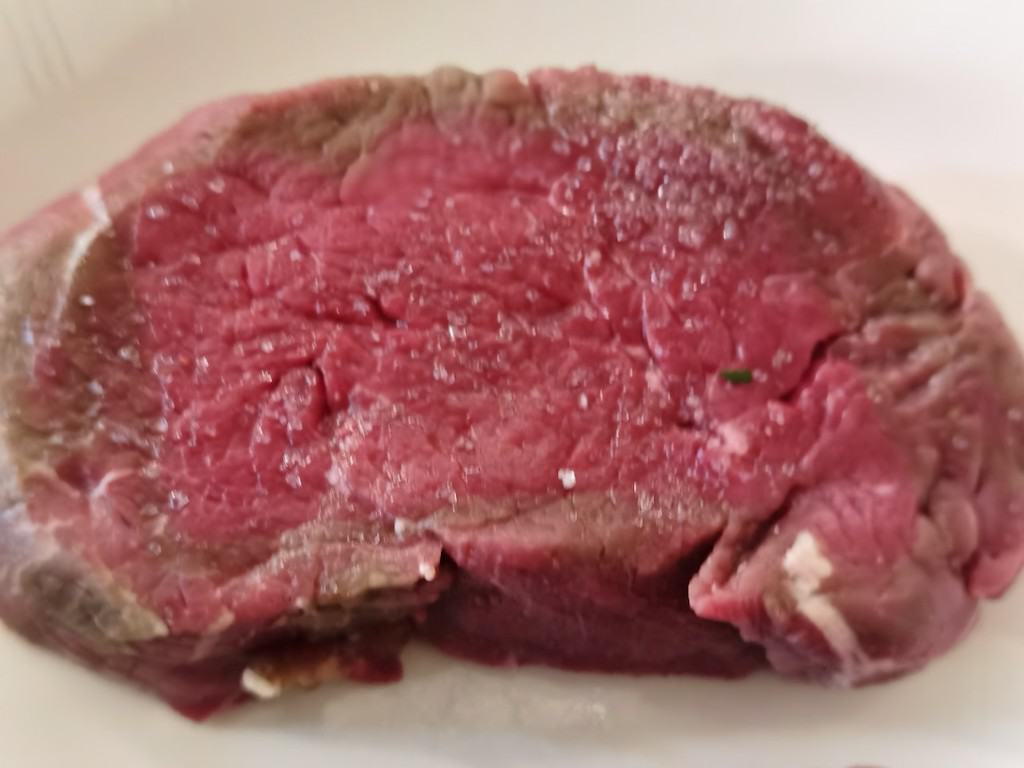
Next up salt the steak. Fans of this method say that a small amount of salt not only enhances its flavour but helps to tenderise the steak too.
Here’s how it works:
When salting, the salt first sits on the surface of the steak and begins to dissolve. A rookie mistake involves chucking the steak in the pan straight after salting it. That doesn’t work because after a minute, the salt draws liquid out of the steak. It’ll pool on the surface of the meat. If you cook the steak at this point, a lot of the heat in the pan gets wasted boiling off the liquid on the steak. Temperatures drop, and searing doesn’t happen.
Instead, sprinkle a smallish amount of salt on the steak and set a timer for 4 minutes. During this time, salt gets reabsorbed by the steak. It begins to break down the outermost fibres of the steak. The meat then becomes more absorbent, allowing the salt to work its way into the rest of the steak. Once this happens, you’re good to go. Be sure to use non-iodised salt, flaked sea salt or pink Himalayan salt is best.
- Pat the steak down
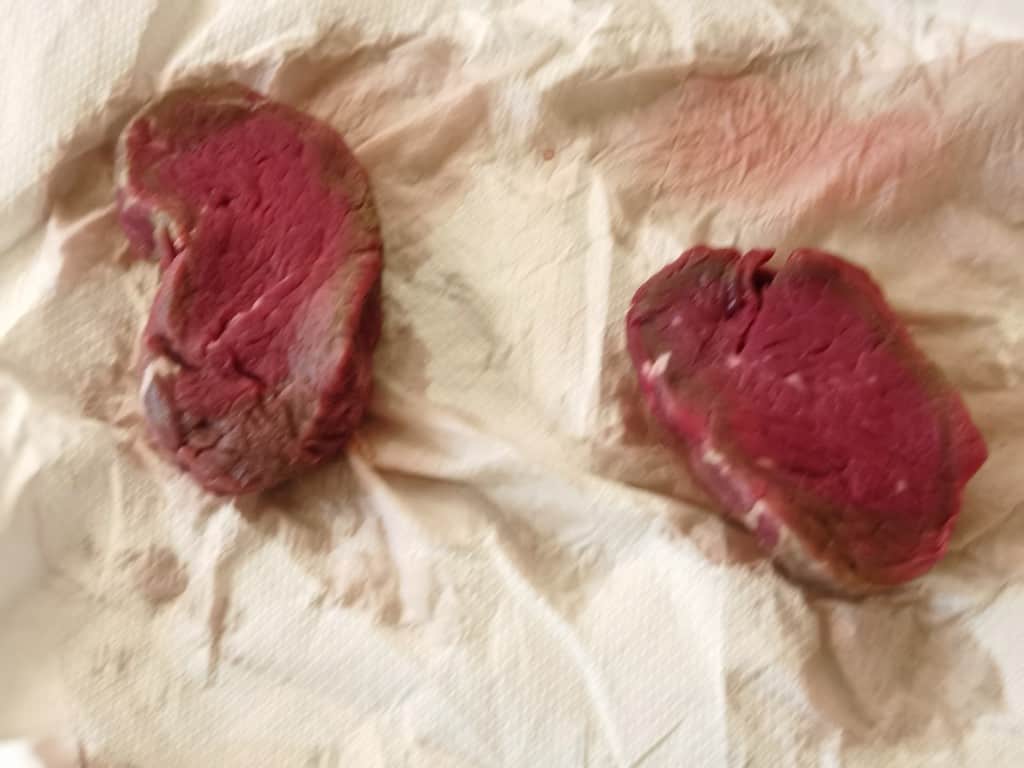
Once the salting is complete, pat down the steak with a paper towel before cooking. This allows the pan to sear instead of boiling off moisture.
For cooking, the gold standard is a cast iron pan. It should be pre-heated to a high temperature, and its surface should be clean. This allows the steak to sear, keep moisture, and develop flavour. Checking that the pan is hot is as simple as putting a water droplet on the pan’s surface. If the water bounces around before evaporating, it’s hot enough. if not wait a few more minutes and try the water test again.
- Oil the steak, not the pan
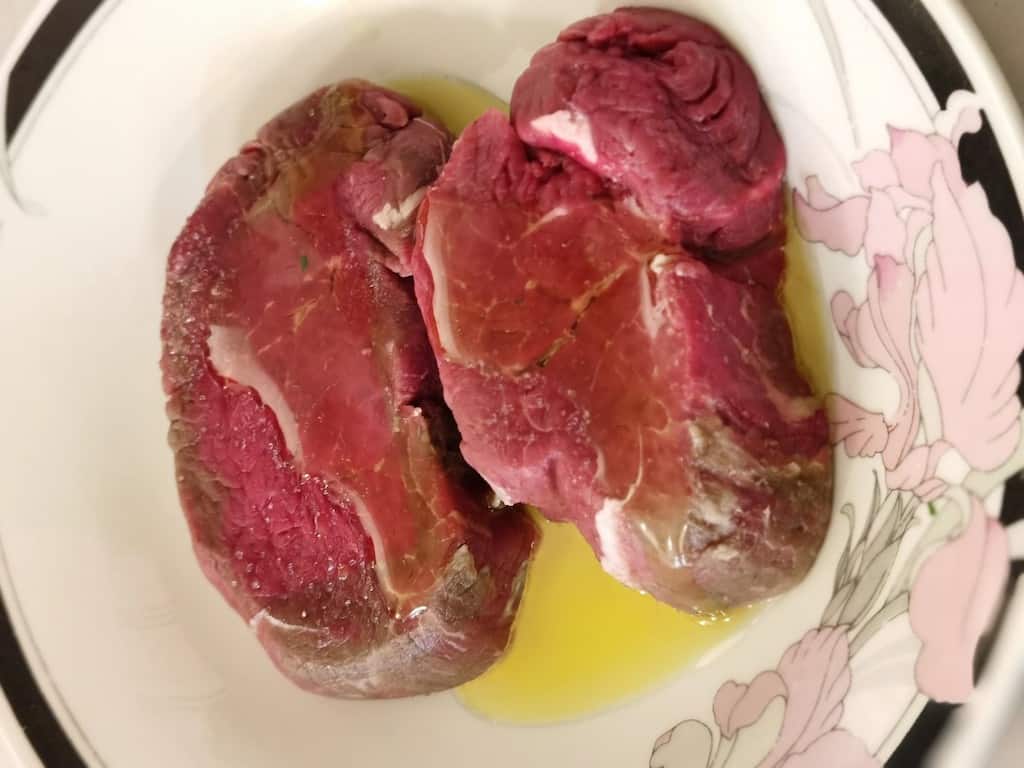
So your steak is dry and the pan is supernova hot. Your next step involves oiling the steak, not the pan. Doing this means the pan and steak won’t smoke so much. Some chefs say is when you start to get carcinogens in your food.
Searing happens when the surface of the steak makes contact with the hot pan and gets heated to about 150c, which causes the proteins to caramelise. A crusty surface keeps moisture inside, which keeps the steak tender. When oiling and cooking a steak, use a neutral-tasting oil with a high smoke point. This could be either sunflower or rice bran oil. Avoid olive or peanut oils as they’ll both impart flavour to the steak
- Cook it
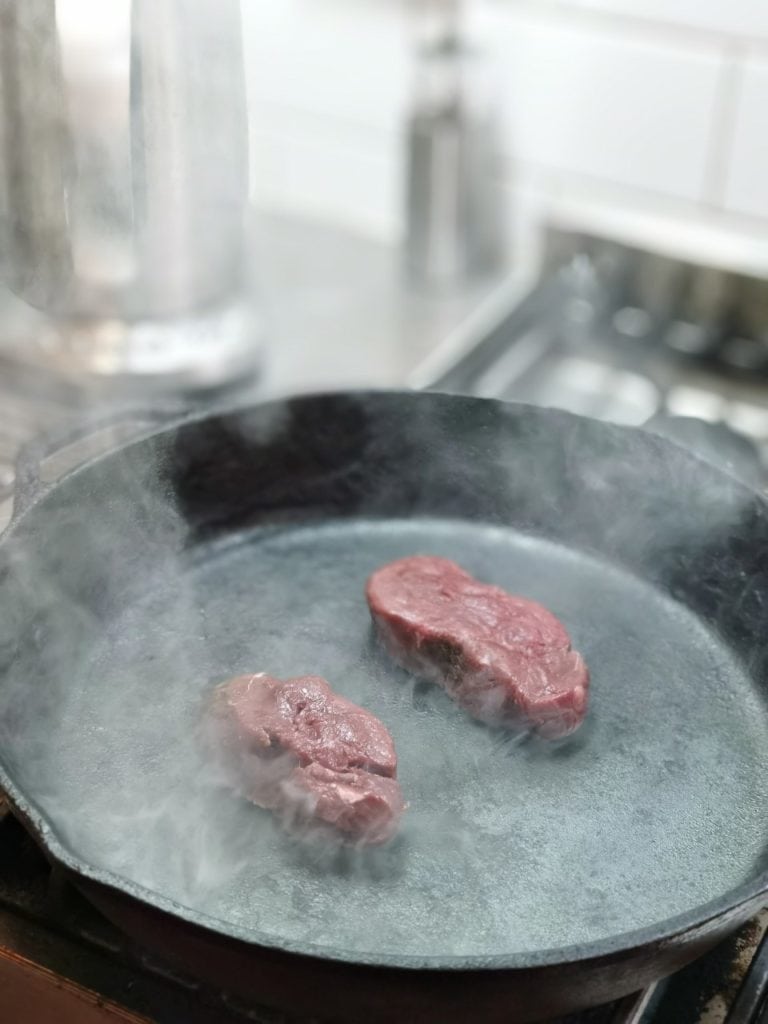
Cooking steak in a pan involves a few simple tricks. When cooking several pieces of steak, make sure there’s plenty of space between them. This ensures that their juices won’t combine and cause the steaks to stew instead of searing.
When the steak is in the pan, turn it. This is especially important if it’s thin cut and will ensure even cooking. Turning a steak doesn’t mean prodding or moving it a lot. Aim for a few minutes of contact with the pan. This allows the steak to sear. When searing is underway, the steak will stick to the pan and release once seared. If the steak doesn’t feel stuck, it is probably ready to get turned.
How long the steak cooks for depends on how you like your steak. A good rule of thumb is as follows:
You can use a good meat thermometer (it’ll measure the internal temperature of the steak). This allows you to tell if it is at a specific stage of cooking. Once the inside of the steak has reached 60-63c, you should (in theory) have a perfect medium-rare steak. If you like your steak medium-well done, aim for 65-69c, and well-done steak should have an internal temperature of 71 or higher.
If you don’t have access to a meat thermometer, try this:
For a medium-rare steak, turn the steak when juice first begins to appear on its upper surface. Cook the flipped side until juice begins to emerge. Giving it a gentle prod with a finger it should feel soft, not firm like a chunk of rubber.
For a medium steak, turn the steak when juice begins to pool on its surface. Cook the flipped side until juice also pools there too. A medium steak will have a firmer bounce when prodded with a finger.
For well-done steaks, do not flip until a lot of juice has pooled on its upper surface. Leave it longer once flipped. The steak should feel semi-firm (but still slightly soft) to the touch.
- Let it rest
Last (but by no means least), a cardinal rule of cooking the perfect steak involves resting it once its cooked. When a steak gets cooked, its fibres tighten. By allowing it to rest after cooking, the fibres relax, resulting in a tender steak (and less blood on your plate).
The best way to rest a steak is to place it on a rack sitting over a plate. This prevents the steak from sitting in its own juices which will ruin its seared crust. Cover the steak a pot lid, or with tin foil and let it sit for 5 – 10 minutes – then serve it. A good rule of thumb is that the thicker the steak, the longer it’ll need to rest.
* Warning: animals were harmed for this recipe. Be kind to animals!

